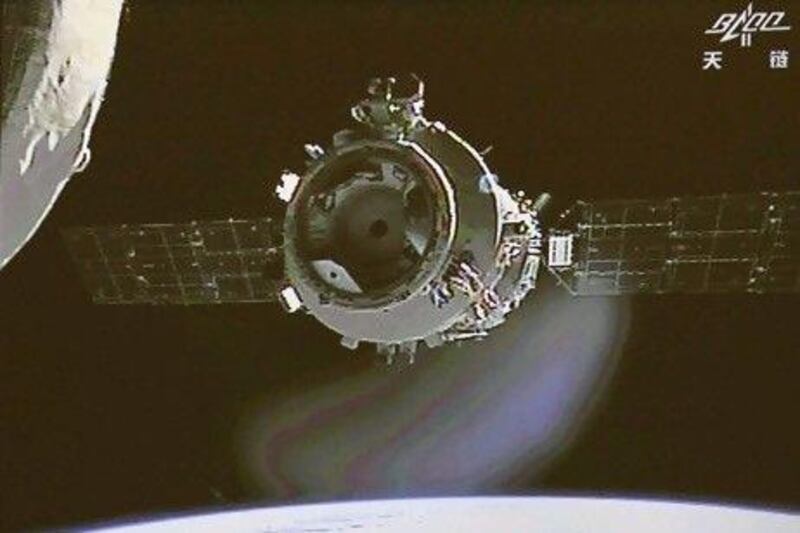Space might be the final frontier but for China it is all about technology and making money.
When the Shenzhou-9 capsule successfully docked with the Tiangong-1 space lab last week, it hit the headlines worldwide - an event made all the more newsworthy by the presence of China's first female astronaut, Liu Yang.
An air force major, Ms Wang is a flight engineer and her presence on the spaceship added an extra layer of glitz to China's mission.
But then, no expense has been spared on the programme, with 35 billion yuan (Dh20.21bn) spent between 1992 and last year as China looks for international prestige and a boost to its technology industry.
According to Yung Kai Leung, of the China National Space Administration's Lunar Exploration Programme Centre, "the intention of the Chinese government in developing its space programme" is that it will create technology used by industry.
"That provides a focus and a pool to improve the country's technological development in the private sector," he says.
A thriving space industry can lead to a wide range of innovations, such as better temperature and pressure sensors, which can be used in a host of sectors. Improved composite materials are another potential benefit.
"I think from the start there are many, many different components - electronic, mechanical as well as [for the] chemical industry," says Mr Yung.
This has certainly happened in Japan. There the sector consists of about 50 main private companies producing satellite and launch-vehicle components, plus other parts manufacturers, says Shigekatsu Horii, the general manager of the space engineering division of the Society of Japanese Aerospace Companies. Key technologies perfected by Japan's space industry include advanced construction materials.
"Japan has state-of-the-art technology and that material is used in the satellite and launch vehicle as carbon fibre-reinforced polymer," he says. "So, the space-related companies in Japan help to improve the global competitiveness of Japanese industry."
But will China's largely state-run space industry, although widely acknowledged to have made great strides since the days when it used recycled Russian technology, bring the same benefits? Dean Cheng in the book Toward a Theory of Spacepower, published by the National Defence University in Washington, pointed out that the space industry represented "a strategic way to enhance [China's] economic, scientific, technological and national defence strength".
"[The] authorities felt improvements in science and technology will lead to improvements in various Chinese industries, which will in turn raise the overall efficiency and productivity of the economy," he writes.
The space programme could advance China's capability with systems integration, seen as "a significant weakness in Chinese industrial and technological capabilities", says Cheng.
"Improvements in this area would probably benefit the Chinese economy as a whole as it propagated across industrial sectors."
Yet what characterises the sector, dominated by the state-owned China Aerospace Science and Technology Corporation, which employs 110,000 people, is an apparent lack of innovation. Only 1 per cent of space-related patents granted between 2000 and 2008 came from China, according to an Organisation for Economic Co-operation and Development report.
Private companies are much less involved in the sector compared with other countries such as the United States.
China has purchased satellites from foreign private companies but has not embarked on the kind of tie-ups between the private and public sectors seen in Europe's space industry.
There, a public-private partnership was behind the Galileo Global Navigation Satellite System, while the United Kingdom used a private finance initiative model to develop its Skynet military communications satellite system.
China has yet to go down this road but that will change, eventually. A report released last year by the US think-tank the Rand Corporation reported that China's 11th five-year plan, which applied from 2006 to 2010, said there should be "greater integration of market mechanisms into the space programme to foster competition". The aim of this, the report said, was to help China secure more market share in the world's commercial space sector.
"China is not closely integrated into the supply chains of foreign space companies, and the market for Chinese products and services such as space launches and satellites is small," the report noted.
Still, the China Academy of Space Technology has supplied communications satellites to Venezuela and Nigeria as well as domestic broadcasters. Typically, a communications satellite sells for about US$200 million (Dh734.6m), while the launch and ground control can add another $100m to the cost.
Just as China's overseas sales of satellites has been limited, its success in the 1990s in undertaking launches for foreign customers faded, partly because the US imposed an embargo on technology.
But as the Rand Corporation pointed out, China's good reliability record for launches with its Long March rockets should help secure more contracts and boost commercial spin-offs.
"In the past, they have made low-grade products because there wasn't the market in China. Now they have such a market, so that will surely give a very important help to improve China's products in the long run. This will benefit many other industries," says Mr Yung.
twitter: Follow and share our breaking business news. Follow us
iPad users can follow our twitterfeed via Flipboard - just search for Ind_Insights on the app.






